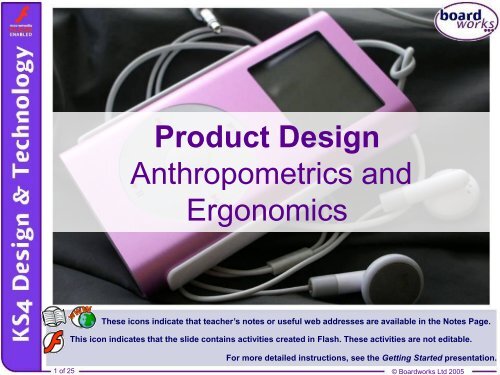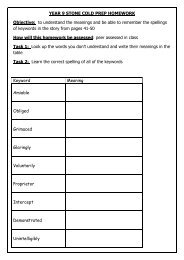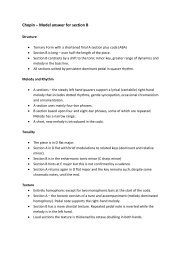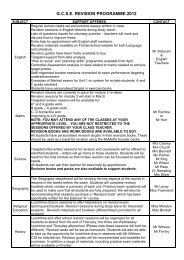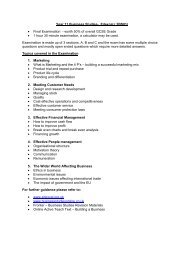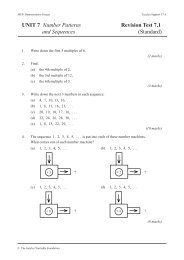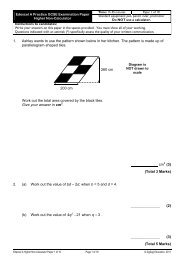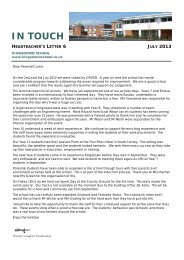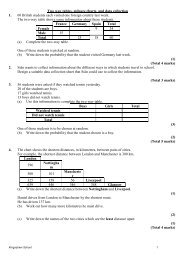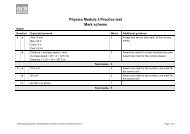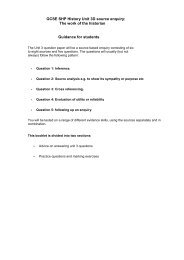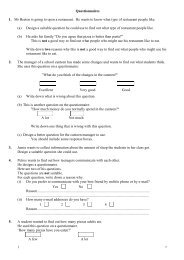Anthropometrics and Ergonomics - Kingsdown School
Anthropometrics and Ergonomics - Kingsdown School
Anthropometrics and Ergonomics - Kingsdown School
Create successful ePaper yourself
Turn your PDF publications into a flip-book with our unique Google optimized e-Paper software.
Product Design<br />
<strong>Anthropometrics</strong> <strong>and</strong><br />
<strong>Ergonomics</strong><br />
These icons indicate that teacher’s notes or useful web addresses are available in the Notes Page.<br />
This icon indicates that the slide contains activities created in Flash. These activities are not editable.<br />
For more detailed instructions, see the Getting Started presentation.<br />
1 of 25<br />
© Boardworks Ltd 2005
Learning objectives<br />
Learning objectives<br />
2 of 25<br />
© Boardworks Ltd 2005<br />
To consider the anthropometrics of potential end<br />
users when designing a product.<br />
To ensure that products being designed are<br />
ergonomically suitable for a range of user groups.<br />
To become familiar with anthropometric terminology.<br />
To be able to place users in a percentile range.<br />
To be able to carry out some empirical<br />
anthropometric research.
Background on anthropometrics<br />
3 of 25<br />
© Boardworks Ltd 2005<br />
If a product is going to be successful <strong>and</strong> meet the needs<br />
of the user group, product designers must use specific<br />
information about the user group, such as their<br />
dimensions <strong>and</strong> physical characteristics.<br />
The dimensions of the human body are called<br />
anthropometrics. This word refers to the actual<br />
measurements of body parts, e.g. the length of an arm<br />
or the width of a foot.<br />
<strong>Anthropometrics</strong> are vital to product design because they<br />
are one of the key product criteria that designers use<br />
when developing solutions.
The study of anthropometrics<br />
4 of 25<br />
© Boardworks Ltd 2005<br />
The word anthropometrics takes its root from two other<br />
words:<br />
Anthropology<br />
Metric<br />
Anthropology is the study of humankind.<br />
Metric describes the universal unit of measurement.<br />
When they are combined, they mean the study of human<br />
measurements.
The study of anthropometrics<br />
5 of 25<br />
© Boardworks Ltd 2005
Using anthropometric information<br />
6 of 25<br />
© Boardworks Ltd 2005<br />
You must decide which group of people your product is<br />
aimed at.<br />
Anthropometric information is provided in tables <strong>and</strong><br />
divided up into different ages, gender <strong>and</strong> nationalities.<br />
SO… you need to know who you are designing for!<br />
A children’s keyboard must have<br />
keys sized for children’s fingers.<br />
A design for an executive office desk for<br />
use in the USA would need to take into<br />
account the anthropometric data for<br />
working adults from America.
Using anthropometric information<br />
7 of 25<br />
© Boardworks Ltd 2005<br />
Work out which body measurements are important.<br />
It is vital to know which parts of the body your<br />
product needs to accommodate.<br />
If you are designing a chair, what<br />
anthropometric information will you need?<br />
Buttock to popliteal<br />
length<br />
Buttock width<br />
Popliteal height
Using anthropometric information<br />
Are you designing for smaller, average or larger people?<br />
No two people have exactly the same dimensions but we all fit<br />
into one of three categories – depending on your dimensions,<br />
you will fall into the 5th, 50th or 95th percentile range.<br />
8 of 25<br />
Most people appear to be a similar<br />
height. These people fall into the 50th<br />
percentile range <strong>and</strong> are considered of<br />
average height.<br />
A small percentage of people are<br />
shorter than this majority – this group is<br />
known as the 5th percentile.<br />
Others are taller than most people <strong>and</strong><br />
belong to the 95th percentile.<br />
5% of the population are smaller than the ‘average’<br />
person <strong>and</strong> 5% are bigger than the ‘average’ person.<br />
About 90% of the population are considered average.<br />
© Boardworks Ltd 2005
Using anthropometric information<br />
9 of 25<br />
© Boardworks Ltd 2005<br />
Look at the people around you now. Let’s carry out some<br />
empirical research.<br />
Arrange yourselves into gender groups (female <strong>and</strong> male).<br />
Within the gender groups, arrange yourselves into height<br />
order.<br />
How many people are ‘average’ <strong>and</strong> how many are<br />
significantly taller or shorter?<br />
Frequency<br />
Shortest<br />
1.5m<br />
Average<br />
1.68m<br />
Tallest<br />
1.85m<br />
Could you plot individual<br />
heights on the graph <strong>and</strong><br />
draw a line through them?<br />
Does it look like the graph<br />
on the previous slide?<br />
If not, are there any<br />
obvious reasons why?
10 of 25<br />
© Boardworks Ltd 2005<br />
Anthropometric constraints<br />
It’s important to think about whether to use the 5 th , 50 th or<br />
95 th percentile anthropometric data.<br />
Consider the following design scenarios <strong>and</strong> discuss why<br />
the particular range has been used.<br />
Designing a car dashboard<br />
5 th percentile measurements are used so that<br />
smaller people can reach the instruments easily.<br />
Designing an aircraft seat<br />
95 th percentile measurements are used<br />
so that larger people can sit in the seat.
Anthropometric constraints<br />
11 of 25<br />
© Boardworks Ltd 2005
<strong>Anthropometrics</strong> of the h<strong>and</strong>s<br />
12 of 25<br />
© Boardworks Ltd 2005
<strong>Anthropometrics</strong> of the head <strong>and</strong> neck<br />
13 of 25<br />
© Boardworks Ltd 2005
<strong>Anthropometrics</strong> of the lower body<br />
14 of 25<br />
© Boardworks Ltd 2005
<strong>Anthropometrics</strong> of the upper body<br />
15 of 25<br />
© Boardworks Ltd 2005
<strong>Anthropometrics</strong> for seating<br />
16 of 25<br />
© Boardworks Ltd 2005
<strong>Ergonomics</strong><br />
17 of 25<br />
© Boardworks Ltd 2005<br />
What is ergonomics?<br />
The word ERGONOMICS comes from the Greek language:<br />
ERGOS = work<br />
NOMOS = natural law<br />
<strong>Ergonomics</strong> is the relationship between a product<br />
<strong>and</strong> its user.
<strong>Ergonomics</strong><br />
18 of 25<br />
© Boardworks Ltd 2005<br />
Ergonomists study products, systems <strong>and</strong> environments<br />
<strong>and</strong> how they fit with their users.<br />
As a product designer, you will need to consider how<br />
well a product meets the ergonomic needs of its user<br />
group in performing a task.<br />
If the relationship between<br />
these aspects in the circle is<br />
weak, the product is<br />
ergonomically unsuitable.<br />
How would a specification,<br />
a product analysis <strong>and</strong><br />
anthropometric data be<br />
useful in this scenario?
Bottle case study<br />
19 of 25<br />
© Boardworks Ltd 2005
Using ergonomics in the home<br />
Designing a kitchen<br />
When designing a kitchen, there are several principles which<br />
are essential to stick to:<br />
The work triangle. For a right-h<strong>and</strong>ed<br />
person, the sequence of activities must<br />
allow movement from left to right from<br />
the sink, to a work surface, to the cooker<br />
(in that order).<br />
Tall cupboards, doors, routes through the<br />
kitchen <strong>and</strong> passageways should not<br />
interfere with the work triangle.<br />
The work triangle must not measure<br />
more than 7000mm (7m) for mediumsized<br />
kitchens.<br />
Using the activity on the next slide, create a kitchen<br />
20 of 25<br />
layout based around an ideal work triangle.<br />
© Boardworks Ltd 2005
Designing a kitchen<br />
21 of 25<br />
© Boardworks Ltd 2005
Car seats<br />
22 of 25<br />
© Boardworks Ltd 2005
Designing a chair<br />
23 of 25<br />
© Boardworks Ltd 2005<br />
The same chair is being used by a 50 th percentile person, a<br />
5 th percentile person <strong>and</strong> a 95 th percentile person. How could<br />
the design of the chair be improved to suit all three people?
Plenary<br />
24 of 25<br />
© Boardworks Ltd 2005
Key points<br />
Key points<br />
25 of 25<br />
© Boardworks Ltd 2005<br />
<strong>Anthropometrics</strong> is the study of body measurements<br />
<strong>and</strong> statistical data concerning the sizes <strong>and</strong> shapes<br />
of the population.<br />
<strong>Ergonomics</strong> is the relationship between a product <strong>and</strong><br />
its users.<br />
All people fall into the 5 th , 50 th <strong>and</strong> 95 th<br />
anthropometric percentile range.<br />
User group, posture, clearance, reach <strong>and</strong> strength<br />
are all important factors in anthropometrics <strong>and</strong><br />
ergonomics.


